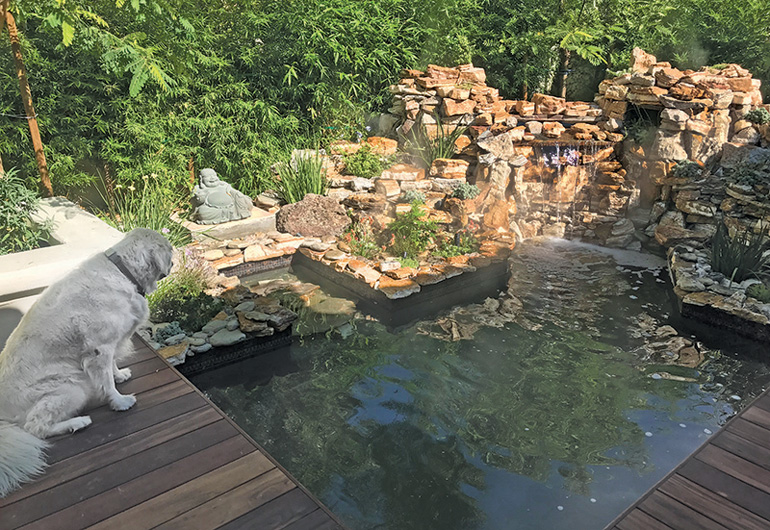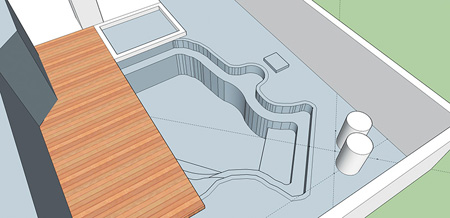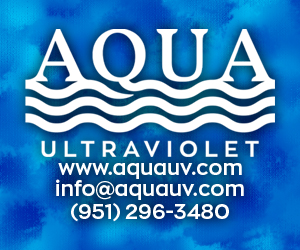
A few months ago, I got a call from a gentleman named Roger who had just bought a house and wanted a pond in his backyard. He had kept fish before, but it was some time ago. Roger also wanted an in-ground spa next to the pond. His friend Jeff had created a dimensional drawing, and I turned it into a 3-D sketch-up drawing they could use for acquiring bids. He contacted some pool contractors, but he wasn’t satisfied with the results. The spa portion turned out to be more expensive than he had imagined, so he decided to eliminate the spa, install additional decking and spend money on making the desert koi pond as nice as possible. The pond needed to reflect the quality of his high-end neighborhood as well as maintain a high resale value down the road. Jeff, who was already in charge of the backyard landscape, decided to handle the pond construction.
Prepping the Design
The pond was going to be solid-filled block and rebar with polyurea as the waterproof coating. This changed the design from free form to one of two combined rectangles. The solid-filled block could be easily constructed, and the polyurea would ensure a long, leak-proof life. Wood decking isn’t very common in the desert because of the high level of maintenance necessary for it to survive the heat, but they wanted to use Ipe decking. I’ve seen Ipe on several jobs here in the desert, and it works well.
The main section of the pond is approximately 8 by 10 feet with a 3-by-4-foot area under the waterfall. At an average of 3 ½ feet deep including filtration, the volume should be just below 3,000 gallons. So a flow rate of 4,000 to 6,000 gph is a good range for the desert environment. We decided to use a 3-inch aerated bottom drain to a 55-gallon drum prefilter, a skimmer and a midwater drain as the suction components. The yard had limited space, so two 55-gallon drum upflow sand and gravel filters are hidden inside the waterfall near the back corner of the property.
The system is powered by a Wlim Wave I ¼-Horsepower pump, which flows approximately 6,000 gph at 9 feet of head. The sand and gravel filters use approximately ¼ feet of head to operate, making this pump more than adequate for the job. I used my 3-inch aerated bottom drain with the flush-mounted, 5-inch air diffuser fed by a Pentair Aquatic Eco-Systems V-301 air pump. This is a great setup for small ponds, and the flush-mounted air disc doesn’t protrude above the bottom drain dome.

Two sides of the pond are edged by the deck with a short overhang. The side opposite the house is landscaped with a Buddha statue, so an edge-mounted skimmer would not have been very attractive in the small space. I mounted one of my Aqua Niche skimmers just inside the decking in the corner, and the midwater drain is directly opposite, about 1 foot off the floor.
Drumming it Down
A 3-inch bottom drain will operate with a 55-gallon drum chamber for the prefilter. I would regularly spec one of my static prefilter kits, because there isn’t much else out there in terms of prefilters for smaller ponds. In this case, I tried something different. I’ve had great results with my radial separators with the 9-inch floating weirs on larger ponds. The larger, 500-gallon versions can flow up to 20,000 gallons per hour but aren’t practical for small projects, so I developed a smaller, 55-gallon drum version. The radial separator also eliminates the need for a buried knife valve. An old-school standpipe is used for water shut-off from inside the tank.

Water enters from the pond bottom drain through the side of the tank and is diverted upward as it travels to the top of a smaller cylinder in the center of the larger radial separators. The circular weir outlets surround the center cylinder on the larger versions. For the 55-gallon drum version, the inner cylinder is offset to one side to allow enough room for one circular weir outlet. The inner cylinder is open at both ends and reaches 1 or 2 inches above the water level at its top. Water entering in an upward direction in the inner cylinder reverses its flow near the top and slows down as it travels downward. When the water reaches the lower edge of the inner cylinder, it reverses again and flows upward toward the outlet. With each reversal of flow, the water slows down significantly, shearing the heavier particles off and allowing them to fall to the bottom of the main tank. This action pulls them out of suspension passively with no moving parts.
The cleanest water exits the tank as the surface-tension water layer by flowing over the rim of the floating weir. My 9-inch circular weirs have a circumference of about 27 inches, allowing for flows of 4,000 to 5,000 gph. The smaller, 6-inch circular weir has a circumference of about 19 inches and creates a high surface tension at a flow rate of 1,800 to 2,000 gph, which is perfect for a 55-gallon drum container. Radial separators do an excellent job of removing particles that are heavier than water. For particles to exit the prefilter, they must be light enough to enter the surface-tension layer of water in the tank, which is difficult, considering the water is coming from the bottom of the pond already.


[box style=”rounded”]The block shell was sealed with polyurea. The 3-inch drain line to the 55-gallon radial separator was installed.[/box]
Radial separators have been around for a long time but couldn’t be used in a pond with a fluctuating water level. The addition of a floating weir allows them to be used anywhere you can install a gravity-flow prefilter. And other than the floating weir, it has no moving parts.
Ease of Maintenance
The outlet side of the plumbing in this system is divided into four runs. Two 1 ½-inch lines connect to the upflow sand and gravel filters. At 22 ½ inches in diameter, these filters should not flow more than 1,800 gph for optimum trapping ability. Above that, the sand layer will start to fluidize, so the balance of 6,000 gph will be returned to the pond through one 1 ½-inch current jet near the pond floor below the Buddha, and one ¾-inch return in the small pool below the Buddha. This allows the filter flows to be easily adjusted, and the return jets can operate as a diversion for water when cleaning the filters without shutting off the pump.
When laying out a set of filtration equipment for a client, my goal is water quality and ease of maintenance. This prefilter has a 3,500-gph discharge pump that sends water to a 2-inch drainage line around the garden. The biofilters have discharge lines that connect to the garden drain line and are cleaned with an air blower that churns up the media and dislodges the collected detritus.
Other than cleaning the skimmer basket, there is no reason to get wet or pull anything out during maintenance.



I have a 2000 gallon pond. I have a bottom drain running thru an oasis multi level Matala filter. I have a skimmer with multi level matala filter. These pipes meet, go thru a UV light then into a pool filter filled with bio balls then out to the pond
Should I have some other filter material in the pool filter?
Should I add a UV light between the bottom drain and the bottom filter
Thanks
Yes, found this reading to be very interesting. I’ve been asked to help design and install an elaborate koi pond in Berkeley, California. I’ve been a plumber for 30 years and have never installed plumbing for a pond, so I’m kind of lost on this one. This pond is in early stages. It is being built at a Buddhist Temple. I would appreciate any help possible. Thank you.
Hey Daniel, Starting out as a plumber actually gives you a big advantage over most. Please call me or e-mail me @ livingwatersolutions@msn.com and we can go over your project!!
Not sure how long such filters function at optimum